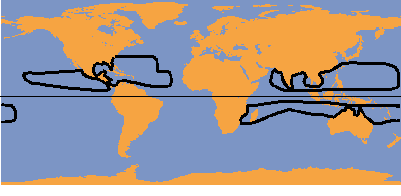Even though Atlantic Ocean hurricanes receive a lot of attention, only 12% of tropical cyclones seen world-wide are located here. These dangerous storms can be found in three of our four oceans, and in both hemispheres. The diagram below shows the regions of the Earth where tropical storms originate.

Approximately 96 tropical cyclones are reported annually. The Western North Pacific Ocean averages more than 25 hurricanes (called typhoons) each year. Another location with great activity is the Indian Ocean. No other part of the world has so much activity in such a small area. This is because of the thunderstorms that develop in association with the nearby ITCZ and the very warm Indian ocean.
The Southern Hemisphere also experiences tropical cyclones. However, they are confined to the Western Pacific and Indian Oceans. Even though ocean temperatures are warm enough, a small region without tropical cyclones exists near the equator. This is because for all the thunderstorm activity that may exist, the coriolis force here is not sufficiently large enough.

names |
|

el nino |